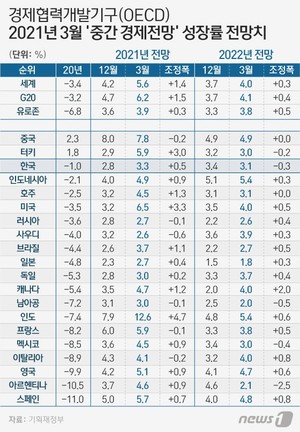[코리아포스트 한글판 김진수기자] The Organization for Economic Cooperation and Development (OECD) raised Korea’s forecast for this year’s growth rate to 3.3% by 0.5 percentage points (p).
Reflecting the effectiveness of the new coronavirus infection (Corona 19) vaccine and policy efforts, the global growth rate forecast was also raised to 5.6%, a 1.4% increase from the previous one. However, we lowered our forecast for China’s growth rate this year by 0.2%p.
In its report on the’Intermediate Economic Outlook’, which was released on the 9th, the OECD presented an outlook for Korea’s economic growth this year at 3.3%. This is a 0.5%p increase from the December forecast.
The OECD previously forecasted that Korea’s economic growth rate for this year was 3.1% in June, August, and September last year, and then lowered the forecast in December last year to 2.8% by 0.3%p.

The OECD predicted that out of the 20 major countries (G20), only 7 countries, including Korea, Turkey, the United States, Australia (above OECD member countries), China, India, and Indonesia, will recover the level of growth before the Corona 19 crisis this year.
Korea’s forecast for this year’s growth rate is 15th out of the 20 major countries (G20). India (12.6%) is the highest, China (7.8%), the United States (6.5%), Turkey and France (5.9%), Spain (5.7%), the United Kingdom (5.1%), Indonesia (4.9%), and Canada (4.7%) ), Argentina (4.6%), Australia and Mexico (4.5%), Italy (4.1%), and Brazil (3.7%).
The OECD predicts that Korea will grow 3.1% by 2022. This is a 0.3%p lowered from last December’s forecast.
The Ministry of Strategy and Finance said, “The growth rate forecast for this year is the best level that exceeds the forecasts of major institutions published so far.” I estimated that it was adjusted”.
The forecast for Korea’s economic growth this year is 3.2% for the government, 3.1% for the Korea Development Institute (KDI) and the International Monetary Fund (IMF), and 3.0% for the Bank of Korea.
The OECD predicted that Korea will recover its pre-crisis economy this year by minimizing the amplitude of the economy compared to other countries, thanks to relatively little Corona 19 damage and rapid recovery.
At the same time, it recommended that major policy efforts be continued for a sustainable and inclusive recovery.
The OECD pointed out that “the support measures implemented throughout the economy at the beginning of the crisis need to be shifted to focus more on the corona19 victims.”
It also suggested the continued efforts of structural reforms such as accelerating vaccine production and distribution and international cooperation, continuing quarantine and maintaining a mitigating monetary policy stance, swift and effective execution of finances, and responding to digitalization and climate change.
The global economic growth rate this year was 5.6%, a 1.4 percentage point higher than in December last year. The growth rate for next year was also raised by 0.3 percentage points from 3.7% in December of last year to 4%.
This year’s US growth rate rose to 6.5% from 3.2% in December of last year, and from 2.3% in December of last year to 2.7%. China’s growth rate was slightly lowered from 8% to 7.8%.
The growth rate for next year is projected to be 4% in the US, 1.8% in Japan, and 4.9% in China.
The Eurozone presented its forecast at 3.9% this year and 3.8% next year.
The OECD believes that the global economy is recovering faster than expected due to advances in vaccines and policy efforts. Accordingly, the existing forecast was raised in consideration of effective vaccines and additional policy efforts of major countries.
The OECD said, “The increase in demand from the US’s large-scale stimulus measures will drive the recovery trend.” “Europe is expected to see a modest recovery this year due to continued blockade measures and limited fiscal policies compared to major countries.”
However, the speed of recovery varies greatly from country to country, and it is believed that most countries will not be able to recover the pre-crisis growth path until next year.
Major risk factors include signs of inflation and weakness in the financial market.
The OECD presented two scenarios related to the global economic growth rate, depending on the pandemic and the speed of vaccine penetration.
It is observed that if the vaccine supply speeds up and economic sentiment recovers early, the global economic growth rate this year will reach 7% and 5% next year.
However, the global economy is expected to grow 4.5% this year and 2.75% next year, if the vaccine supply is delayed and uncertainties intensify due to the large-scale spread of the variant virus.
Copyright © Korea Post Unauthorized reproduction and redistribution prohibited
